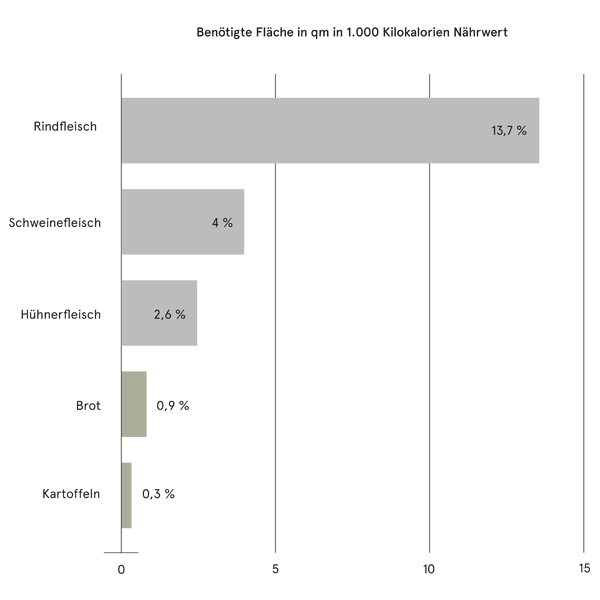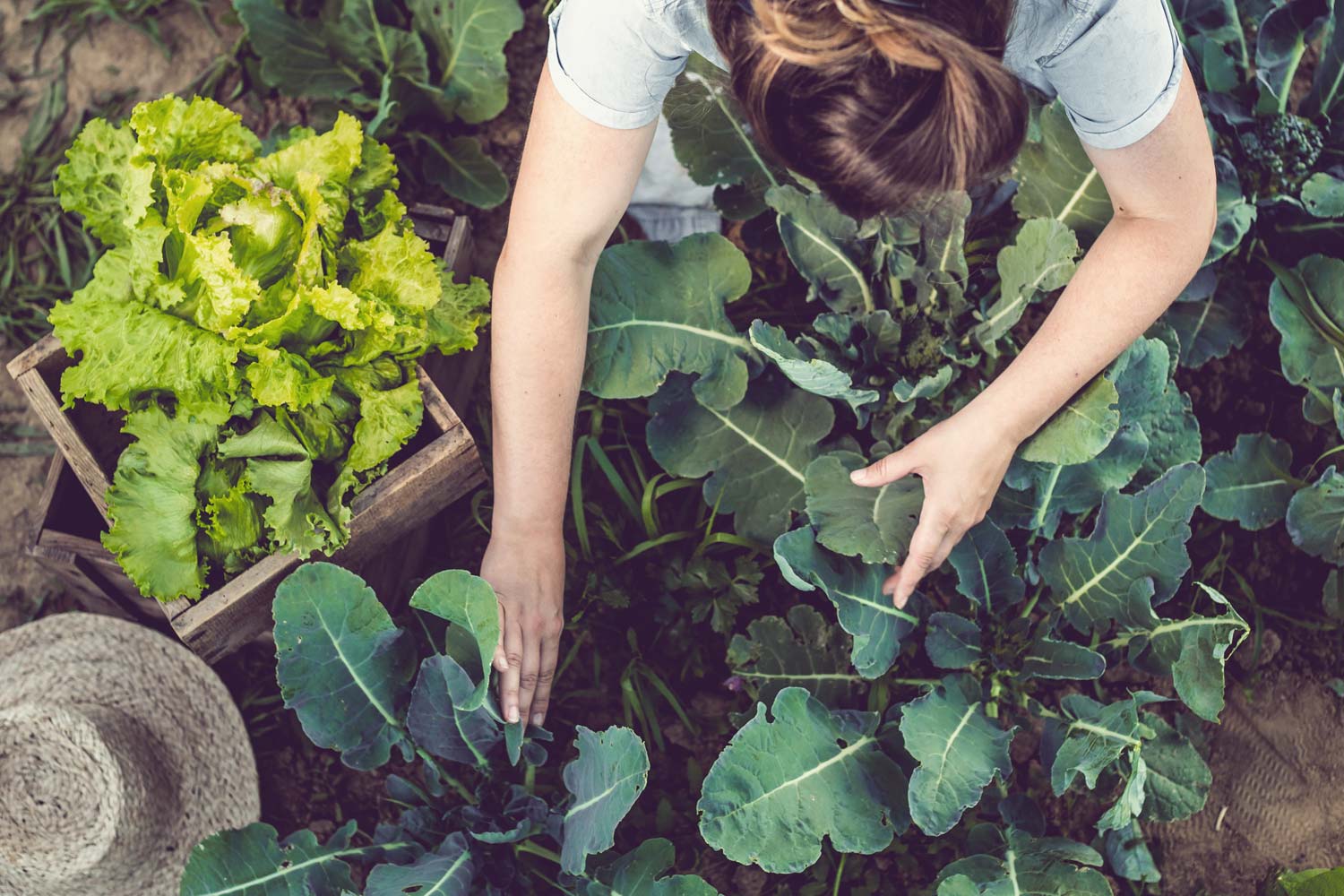Try to imagine this number: 145,000,000 tons. This is how much CO2 we cause per capita in Germany through our diet, that is an average of 1.69 tons. That is way too much and we can all help make it less. Let's talk about it!
How does our diet affect the climate?
Almost every day-to-day activity in our everyday life causes the greenhouse gas CO2, which is driving climate change. On average, every German comes to a good 11 tons per year, says thatFederal Environment Agency.
Our diet accounts for 15 percent of our CO2 emissions.
That is 1.75 tons of CO2 per person. How does this high proportion of greenhouse gases come together??

First of all, we must state thateach of us an average of 500 kilograms of food takes in annually (drinks not included). Not only do they have to be produced, but also transported. Much of our food is imported via flights or freighters.
But Germany itself also produces food on a large scale.We use 50 percent of the land area for agriculture – the majority of it even for intensive or industrial agriculture, in which land areas are heavily exploited and ecosystems are attacked..
This is particularly the case for factory farming, which requires an extremely large amount of land. Some people like it very much, but it is also true that animal food is onevery inefficient foundation.

Animal husbandry, especially for the production of dairy and meat products, is one of the largest sources of CO2 worldwide. Wholee 20 percent of global emissions are due to it. The high value is mainly due to the emissions of the animals themselves, but also due to the large amount of feed they need:
You need for one kilogram of porkfive kilograms of cattle feed.
This shows that we increase our own carbon footprint by consuming animal products. Of themirrors has calculated:
If we would all eat a quarter less meat, we would save 0.1 metric tons of CO2 per capita.
A fully vegetarian diet prevents a total of 0.45 tons of CO2, i.e. a quarter of the CO2 emissions caused by diet.
Our consumption habits are part of the problem. How much CO2 do you produce
Our CO2 emissions are closely related to climate change. And we know that we have to produce significantly less CO2 so that we don't overheat this planet and make it uninhabitable.
In an interview, Federal Environment Agency expert Dr. Michael Bilharz:
“[] for reasons of climate protection we have to by 2050 at the latest to less than one tonne of greenhouse gas emissions per person per yearJahr come to meet the Paris targets to keep global warming below two degrees.“
From over 11 tons to less than one.
That sounds difficult, but it has to be feasible somehow. Politics and industry are in demand here, but so are you and all of us.
So how can we save CO2?
First of all, it is good to get an overview of how much CO2 you cause per year. You can do that with theCO2 calculator from the Federal Environment Agency very easy to roll over.
We tested the tool for ourselves and knew more in less than a minute (we are below the average of 11 tons ourselves, but we also know that we need to save even more CO2).
Another app for calculating CO2 is theClimate compass from Worldwatchers. Here you can even more easily compare how your CO2 emissions change, for example if you eat little instead of a lot of meat or if you buy mainly regional food.
Whether it is one or the other CO2 calculator: The bottom line is that the same principles are used to make your life (and especially your diet) more environmentally friendly:
5 basic principles for a climate-friendly diet
1. Type of food
Which products do you choose?
Most of the emissions are related to meat and animal products. The less you buy and consume of this, the lower your carbon footprint will be.
That doesn't mean that you have to be completely vegan right away, the climate is happy about it, but if you, for example, reduce your meat consumption and only buy organic meat, that's already a big step forward.
2. Seasonality
Is your food ripe?
Fresh strawberries, zucchini or tomatoes are not really available in winter. They either have to be produced at great expense, frozen in a non-ecological way, or imported (see the next basic principle). This creates more CO2 than with seasonal products.
Therefore, when shopping, make sure that you are buying groceries that are in season or that they can be stored well.
You don't even have to do without summer flavors in winter: you can use strawberries to make jam, for example. And if you have green electricity, you can also freeze it in a climate-friendly way.
3. Regionality
Where does your food come from?
Many things simply do not grow in Germany, coffee, mangoes, coconuts, pineapples and have to be brought here. A lot of greenhouse gases are generated by the flight, the freighter and generally by the transport.e.
But many dealers also import many products that would also grow here: inside, sometimes even from outside Europe. (We saw white wine from South Africa the other day!)
It's best to take a close look at where your food comes from and use the regional alternative.
4. Thrift
How much you need
Food waste is a real problem.12 million tons (!) we throw away every year in Germany. That translates to 150 kilograms per head.
This means that not only valuable food ends up in the bin (while too many people continue to starve), but also a lot of CO2 at the same time.
One way is good planning, so only buy as much as you need. You also don't have to take the best-before date so seriously. It's not an expiration date.
To avoid waste, more and more people are saving food: apps likeToo good to go tell you which supermarkets, bakeries, restaurants and snack bars sell leftover food at a low price that they would otherwise have to throw away.
Such solutions make perfect sense: you buy food that is still good, save money and protect the climate.
5. Packaging: How much garbage does your food produce
The production of plastic, glass and paper is currently also causing CO2 Plastic specifically is a protracted problem in the seas.
Avoiding garbage will be important for a bright future. The solutions to this are obvious:
You can pack most of the vegetables and fruit in your own cloth bag, for example, and the same applies to bread if the bakeries play along
And: Many shops offer more and more unpackaged items. So it pays to have Tupperware boxes or other reusable containers with you when you go shopping.
A word on our own behalf
Your carbon footprint not only depends on your diet, but also on the products you buy. We therefore find it important to find out about the sustainability of the providers who produce certain things:
You can often find information on manufacturers' websites on how to use natural resources, how to avoid plastic, and so on. Check this information critically, because a lot is often green dyeing. It is good when providers can prove their activities, for example through partnerships like thisEden Reforestation Projects.
At sober , too, you can find out how we can help you (and all of us)climate-positive cosmetics produce.
Take good care of the climate and yourself! #TreatYourself
Anne

